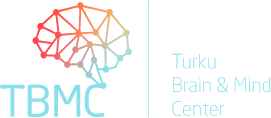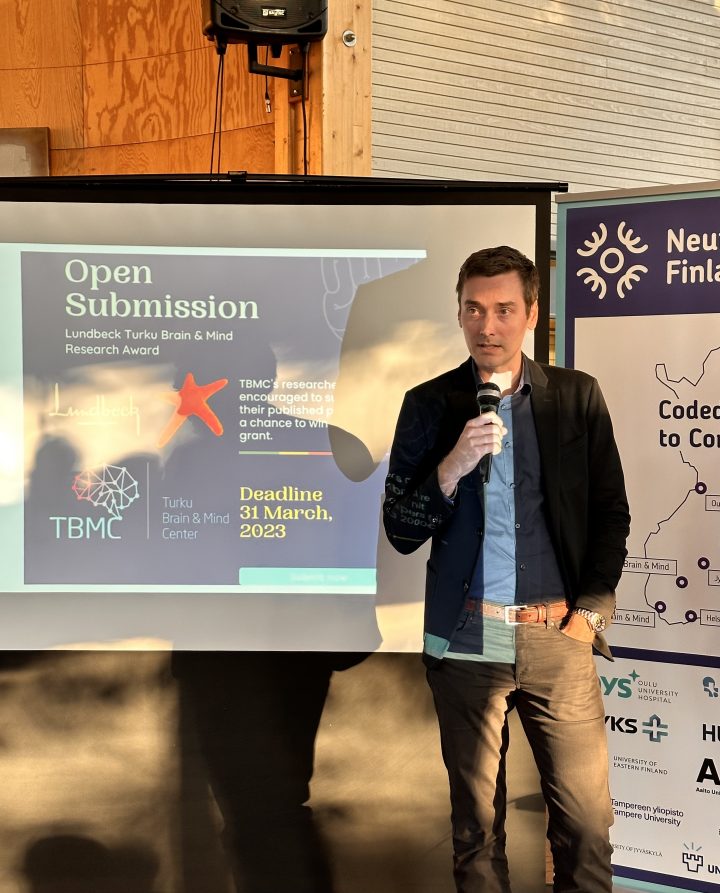Introducing a New Research Recognition
A Common Brain Circuit for Addiction Remission
In the first edition of the Lundbeck Turku Brain and Mind Research Award, the prize was awarded to Professor Juho Joutsa and his team for their paper, “Brain lesions disrupting addiction map to a common human brain circuit,” published in Nature Medicine. Lundbeck’s Country Manager Jimmo Maikola announced the winner during the second networking event organized by Turku Brain and Mind Center (TBMC) on Friday, 1 September 2023.
The Lundbeck Turku Brain and Mind Research Award highlights the first collaboration between Lundbeck Pharmaceutical Company and TBMC on research excellence. A prize of €2000 is awarded to the best paper published in 2022 and affiliated to TBMC. The selection process for the winner was meticulous, focusing on criteria encompassing novelty, research methodology, and the potential impact on the field of brain disorders. Out of the proposed papers, a distinguished panel of judges chose Juho et al.’s groundbreaking research, which demonstrated excellence across all evaluation criteria. Their collective judgment highlighted this research’s pivotal role in confronting a global challenge: addiction and substance abuse.
The Birth of a Revolutionary Idea
The journey began while Juho was a postdoc at Harvard University, where he was introduced to a cutting-edge technique known as “lesion network mapping.” This technique showed great promise in understanding complex neurological symptoms. Starting with the neural networks underlying movement disorders, Juho and his colleagues began investigating possibilities to identify treatment targets using the new technique.
“As weird as it may sound, there are also cases where a brain lesion, such as caused by a stroke, can benefit the patient by improving their pre-existing symptoms. As a proof-of-concept, we studied lesions that have improved essential tremors and found that lesion network mapping precisely predicted the location of the current neurosurgical target of tremors, which we know are highly efficacious. This gave us confidence that this technique could be used to identify treatment targets for disorders where the targets are unknown.”
This discovery sparked the work towards the awarded study, investigating treatment targets for addiction. “Addiction is a major public health problem with limited treatment options and therefore a perfect candidate to test this new approach and find something, which could really move the field forward.”
The Circuitry of Addiction Remission
The main data in the paper was based on smoking addiction, studying patients with brain lesions and data on their smoking addiction outcome after the occurrence of the lesion, with some remitting from their addiction.
“To uncover the underlying neural mechanisms responsible for addiction remission, we explored whether specific lesion locations in the brain consistently led to addiction remission. If all such lesions converged in one spot, it would represent an ideal target for addiction treatment.”
However, no single, consistent brain location was associated with addiction remission. The team found out that lesions were not random but part of a common circuit in the brain. “The evidence that the lesions are part of one circuit encouraged us to also look into other types of addictions, including alcoholism and drug addiction. Across all these datasets, the evidence consistently pointed towards a common addiction remission circuitry.”
Without the team known at the time, ongoing treatment trials using transcranial magnetic stimulation (TMS) showed positive results in facilitating smoking cessation and treating alcoholism. However, these trials were designed to target other brain regions than indicated by Juho’s research and the wanted to understand why. “Remarkably, when we compared the electric field models (i.e., where the stimulation effect is the strongest) of the coils used in these trials, we found that the electric field maxima aligned almost perfectly with the optimal treatment targets predicted by our addiction circuitry, providing strong evidence that we were onto something big.”
The paper, which took several years to complete and was published in 2022, underwent a rigorous peer review process with multiple rounds of revisions. However, this dedication paid off as the paper was eventually published in Nature Medicine, and the study has been covered worldwide, including prestigious forums, such as The New York Times and Nature.
Ongoing Projects and International Collaboration
Currently, Juho leads Turku BrainLab, which has numerous ongoing projects with a key emphasis on moving from lesion network mapping towards new treatments for brain disorders. Their efforts have resulted in the world’s largest prospective lesion network mapping dataset covering a wide array of neurological and psychiatric symptoms, including addiction. “The main issue that limits the use of this novel approach is the available lesion data. To overcome this limitation, we aim to collect the most comprehensive lesion network mapping dataset to date.”
Moreover, Juho is leading an international study involving 15 centers around the world to decode the mysteries of lesion-induced movement disorders. The ultimate aim of this project is to fully characterize these disorders and develop diagnostic and treatment guidelines, which are currently lacking.
A New Role and a Vision for the Future
With his recent appointment as a Professor of Neurology, Juho’s vision for the future is clear. His ambition is to develop the field of clinical neuroscience in Finland, fostering collaboration between clinicians and neuroscientists.
“What drives the field forward are the major findings, which are robust and novel. I strongly believe that our scientific community should work more towards maximizing the quality over quantity. In addition, combining different ideas and approaches through collaboration is the key to achieving remarkable scientific outcomes. Teamwork is always the way to go forward.”
Read the full article:
https://www.nature.com/articles/s41591-022-01834-y
Read the research briefing that described the study:
https://www.nature.com/articles/s41591-022-01864-6

